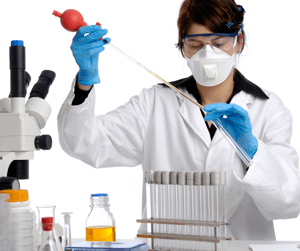The temptation to take shortcuts is strong. In laboratories, where precision, safety and adherence are key, the consequences of these temptations can be particularly severe.
Yet in a high-stakes environment, there may also be the desire to expedite processes, cut costs or simply find an alternative piece of equipment to do the job. As a lab manager, you may have even had the urge to deviate from established safety protocols by investigating the use of lab safety equipment alternatives.
While these alternatives may seem like a convenient solution to budget or supplies issues, the question you must ask yourself is: Are these lab safety equipment alternatives acceptable? The answer to that question depends on a careful evaluation of the specific risks, regulations and circumstances within your laboratory.
Examples Of Lab Safety Equipment Alternatives
While traditional safety equipment such as lab safety goggles, lab coats and gloves are standard, there are alternatives and variations that may be used depending on the specific circumstances, materials or budget constraints.
and variations that may be used depending on the specific circumstances, materials or budget constraints.
For example, here are some lab safety equipment alternatives:
- Lab Safety Glasses or Goggles Alternatives:
- Face shields: These transparent shields provide full-face protection against splashes, chemicals or other hazards.
- Safety goggles with indirect ventilation: Goggles with indirect ventilation systems can reduce fogging and discomfort during extended use.
- Prescription safety glasses: For individuals who wear prescription glasses, prescription safety glasses can be a more comfortable and practical alternative to safety goggles.
- Lab Coat Alternatives:
- Disposable lab coats: These are more convenient and can be disposed of after use, reducing the need for laundry and maintenance.
- Aprons: In situations where full lab coats may not be necessary, disposable or reusable aprons can protect the front of the body.
- Tyvek suits: In highly hazardous environments, Tyvek suits provide comprehensive protection against chemicals, particulates, and other contaminants.
- Gloves Alternatives:
- Nitrile gloves: Nitrile gloves are a popular alternative to latex gloves, as they are hypoallergenic and provide good chemical resistance.
- Cut-resistant gloves: When working with sharp objects, such as glassware or blades, cut-resistant gloves can offer additional protection.
- Heat-resistant gloves: For tasks involving high-temperature materials or equipment, heat-resistant gloves can provide protection against burns.
- Respiratory Protection Alternatives:
- N95 or KN95 masks: These masks offer protection against particulate matter and can be an alternative to more elaborate respiratory protection equipment.
- Half-face respirators: These are an alternative to full-face respirators when protection against airborne contaminants is needed.
- Hearing Protection Alternatives:
- Earplugs: Disposable or reusable earplugs can provide hearing protection against loud equipment or noisy environments.
- Earmuffs: These can be worn over the ears to protect against loud noises and offer a more comfortable alternative for extended use.
- Emergency Equipment Alternatives:
- Safety showers and eyewash stations: Portable or self-contained units can be alternatives to built-in emergency showers and eyewash stations, especially in smaller labs or temporary setups.
- First aid kits: You may opt to build your own first aid kit rather than purchase already-prepared kits. Make sure these kits are well stocked and labeled correctly so that employees can easily find them in the event of minor injuries and incidents.
While these lab safety equipment alternatives can come in handy when you’ve unexpectedly run out of supplies or operate in an environment where safety protocols aren’t as stringent, it’s important to know when it’s appropriate and not appropriate to use them.
When Are Lab Safety Equipment Alternatives Acceptable?
The use of lab safety equipment alternatives should be approached with caution and a thorough understanding of the specific risks and regulations in your laboratory. While these alternatives can be helpful in certain situations, there are times when they may not be acceptable or safe to use.
specific risks and regulations in your laboratory. While these alternatives can be helpful in certain situations, there are times when they may not be acceptable or safe to use.
Here are some considerations for when lab safety equipment alternatives are acceptable:
- Risk Assessment: Conduct a comprehensive risk assessment to determine the specific hazards in your laboratory. Consider the nature of the materials, equipment and tasks involved. Alternatives may be acceptable for lower-risk activities, but higher-risk tasks may require standard lab safety equipment.
- Regulatory Compliance: Ensure that any alternatives chosen comply with local, national and international safety regulations. Failure to meet these standards can result in serious consequences and risks to laboratory personnel.
- Emergency Preparedness: Consider the availability of emergency response equipment and procedures. Some alternatives, such as portable safety showers and eyewash stations, can be acceptable as temporary measures but should not replace built-in emergency equipment in the long term.
- Material Compatibility: Ensure that the alternative equipment is compatible with the specific materials or substances being used. For example, not all glove alternatives offer the same level of chemical resistance.
- Training and Education: Personnel should receive proper training on the use of any alternative safety equipment. Inadequate training can lead to a false sense of security and potentially unsafe conditions.
- Budget Constraints: While budget constraints may necessitate the use of alternatives, safety should not be compromised. It's essential to balance cost considerations with the safety of laboratory personnel.
- Temporary Measures: Alternatives can be acceptable as temporary solutions while waiting for standard safety equipment to be replenished or repaired. However, long-term reliance on alternatives is not recommended.
The acceptability of lab safety equipment alternatives depends on the specific circumstances and the level of risk involved. When in doubt, consult with safety experts, and never compromise on the well-being of individuals working in the laboratory.
Alternative Lab Safety Supplies You Should Never Use
Although some of the alternative lab safety equipment pieces we outlined above MAY be acceptable for your laboratory or workspace, there are some lab safety supplies that should never be compromised or changed unless a safer alternative is available.
For example, here are some pieces of lab safety supplies that are fundamental to ensuring the safety and well-being of workers:
- Fire Extinguishers: Fire extinguishers are specialized safety equipment designed for quick response to fires of different types, such as Class A (ordinary combustibles), Class B (flammable liquids) and Class C (electrical fires). Substituting alternatives could lead to ineffective fire suppression and greater fire hazards.
- Fire Blankets: Fire blankets are designed to smother fires involving people or clothing. They are made of fire-resistant materials and should not be substituted with ordinary textiles or materials.
- Lab Safety Signs and Symbols: Lab safety signs and symbols are standardized and universally recognized, conveying crucial information about hazards, safety procedures and the location of safety equipment. Using alternatives for these signs and symbols can lead to confusion and a lack of understanding among lab personnel.
- Biological Safety Cabinets: These specialized enclosures are designed to protect personnel from harmful fumes, aerosols or biological agents. Substituting alternatives for these primary containment systems can compromise safety.
- Gas Detection Systems: Gas detectors are crucial for monitoring the presence of hazardous gasses or vapors in the lab environment. These systems must be accurate and reliable, and there are no practical alternatives for them.
- Radiation Safety Equipment: Equipment designed for radiation protection, such as lead shielding, dosimeters and radiation warning signs, should not be substituted with non-specialized alternatives, since they provide specific radiation safety measures.
- Chemical Fume Extractors: These systems help remove hazardous chemical fumes and vapors from the laboratory air. Using alternatives may not adequately protect lab personnel from exposure to toxic substances.
- Biosafety Cabinets (BSCs): These cabinets provide primary containment in microbiological laboratories. Substituting alternatives could compromise containment and increase the risk of exposure to infectious materials.
- Personal Protective Equipment (PPE): While alternatives can be used for specific PPE items (e.g., nitrile gloves instead of latex), certain PPE, such as respiratory protection or chemical-resistant suits, should not have alternatives substituted unless they are specifically designed and certified for the same level of protection.
For equipment and features critical to lab safety, it’s essential to use only specialized, standardized and certified solutions. Substituting alternatives for these items can compromise safety and may lead to severe consequences in the event of an emergency or hazard.
Always adhere to established safety guidelines and regulations when it comes to laboratory safety equipment.


